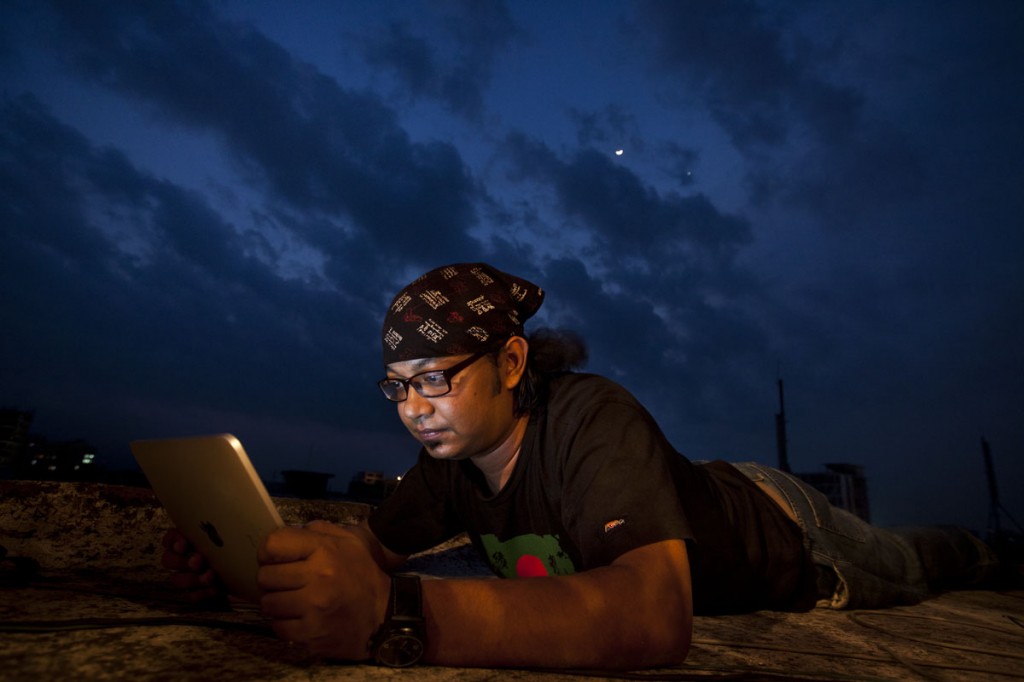Rick Smolan, the man behind the “Day in the Life” books, dispatches an army of photographers and researchers to capture how data is changing the world.
 During the first day of a baby’s life, the data generated by humanity is 70 times the information contained in the Library of Congress.
During the first day of a baby’s life, the data generated by humanity is 70 times the information contained in the Library of Congress.

Big data, one of tech’s biggest buzz phrases of the moment, is about to get its own book. Fittingly, a really big, 7.5-pound book.
Called “The Human Face of Big Data,” this is the latest project by longtime photojournalist Rick Smolan, the one-time National Geographic photographer who’s best known for creating the “Day in the Life” series of books.
Smolan’s approach for this work was the same as the one he’s used for his main prior projects: He dispatched an small army — in this case 100 photographers and 22 researchers going at it for a year and a half — to capture and illustrate one topic. Big data is a tough one, for sure, not as visually obvious as, say, “The Obama Time Capsule,” which chronicled Obama’s first presidential run and his first 100 days in office.
 Rick Smolan
Rick Smolan(Credit: Techonomy)
Which is why Smolan needed some convincing. “It just sounded so fluffy,” said Smolan, whom I met up with at this week’s Techonomy conference in Tuscon, Ariz., where he presented some of the images and findings from the book.
Before taking on the project, Smolan asked all sorts of tech bigwigs to describe big data for him, including Twitter and Square founder Jack Dorsey and former Google CEO Eric Schmidt. But it was Marissa Mayer, now Yahoo’s CEO, who talked about it in a way that made him to decide to do the book.
“She said big data was ‘like watching the planet develop a nervous system,'” said Smolan. “She talked about things like using satellites to look for mosquito infestations. Everyone else had been explaining how much data there is and talking about overlapping patterns. It wasn’t clear to me until she explained it.”
The book, which has a planned publication date of December 4, is packed with powerful portraits of how life is changing in a world filled by a never-ending stream of data — from constant Facebook updates to signals from our smartphones to new data-driven ways to predict heart-attacks in real time. There’s an ongoing data-collecting component of the project as well. Smolan released accompanying mobile apps in September and, with permission, has been recording data of people’s lives from around the world that he’ll publish in a couple of weeks.
Here’s a taste of the book:
In the South Pacific, a group of marine and climate scientists (through the Integrated Marine Observing System), have attached devices to elephant seals to help measure current and topography, and to show migration patterns:
 (Credit: Chris Oosthuizen, University of Pretoria, 2012; from “The Human Face of Big Data”)
(Credit: Chris Oosthuizen, University of Pretoria, 2012; from “The Human Face of Big Data”)Sixty sensors placed in the ocean are constantly collecting and sharing data emerging from a network of sensor floats, underwater autonomous vehicles, scientific monitoring stations, and remote satellite sensing:
 (Credit: Chris Oosthuizen, University of Pretoria, 2012; from “The Human Face of Big Data”
(Credit: Chris Oosthuizen, University of Pretoria, 2012; from “The Human Face of Big Data” A Mountain View, Calif.-based company called Shotspotter uses acoustic sensors placed at intervals throughout neighborhoods to record the sound of gunfire. It triangulates the sounds and pinpoints the sources of those blasts on a map within seconds. About 70 cities now use it, helping police use data to quickly locate crime scenes:
 (Credit: Annie Tritt, The New York Times / Redux 2012; from “The Human Face of Big Data”)
(Credit: Annie Tritt, The New York Times / Redux 2012; from “The Human Face of Big Data”)A crowd-sourcing initiative called the Quake-Catcher Network, developed by the U.S. Geological Survey and Stanford University, has enlisted thousands of people from 67 counties who are helping detect earthquakes. Participants install software on their computers that reads vibrations and shoots messages to the network’s servers:
 (Credit: Koichi Kamoshida, Getty Images, 2012; “The Human Face of Big Data”)
(Credit: Koichi Kamoshida, Getty Images, 2012; “The Human Face of Big Data”) After finishing the project, Smolan became such a convert that he argues that “big data will have a bigger effect on humanity than the Internet” because knowing so much more about the world via data lets us anticipate and potentially solve problems.
“It’s like watching the planet wake up,” he said.
Please Retweet #bigdata #drik #shahidul
